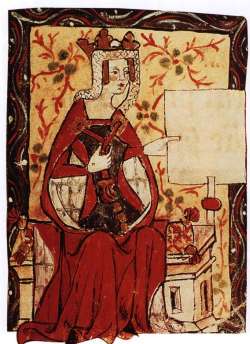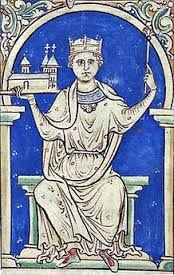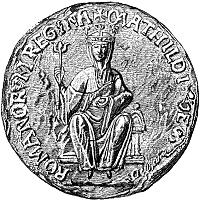
Empress Matilda is an often-overlooked medieval noble, but her life certainly warrants attention. She was the daughter of a king, Henry I of England, and her dynastic birthright would become the nation’s focus during her middle years. In A.D./C.E. 1114 she became the wife of an emperor, Henry V of the Holy Roman Empire, and although she was only twelve at the time of the wedding she soon entered imperial politics. A few years after the marriage, she ruled Italy on behalf of her husband until they reunited in 1119. She would help him administrate the imperial government and suppress rebellions until his death in 1125.
Despite Matilda’s impressive imperial career, her reputation as a powerful individual rapidly grew after her return to England. When Matilda’s husband died without an heir, Henry I sent for her to return to his court since she would no longer have a role in German politics. She obeyed and was married to Geoffrey, the heir to the County of Anjou, in 1128. The new couple had a stormy relationship, as Matilda refused to tolerate the infidelity and apparent disrespect of her husband, twelve years her junior. The following year, she left him in Anjou and departed to live in England, eventually asking her father to allow her to formally separate from Geoffrey. Her request was denied, but it was an unusually bold action from a medieval woman.

The former empress also was a capable ruler and politician, qualities she demonstrated during the Anarchy, a decades-long civil war. In 1120 Henry I’s only legitimate male heir, William, died in the White Ship Disaster, leaving him with no son to inherit the throne. He remarried in 1121 and attempted to father another but was unable to do so. With no other options, he named Matilda, his last legitimate child, his heir in (c.) 1127 and forced his nobles to swear an oath of loyalty to her. The nobles weren’t particularly enthusiastic about having a female leader, especially one married to the much-disliked Geoffrey Plantagenet. Consequently, when Henry I died in 1135, Matilda’s cousin Stephen, Count of Blois, seized the throne with the backing of most of England’s nobles.
In 1139 the civil war began in earnest. Matilda, with the support of her half-brother Robert, Earl of Gloucester, and her uncle David I, King of Scotland, invaded England to combat Stephen’s usurpation. Her forces engaged in a series of skirmishes and sieges, while an army commanded by Geoffrey fought Stephen’s supporters in Normandy. In 1141 Matilda gained the advantage and traveled to Westminster for her coronation. There, she was proclaimed “Lady of the English,” but an uprising among the citizens of London (partially due to the coarse way she dealt with them) forced her to flee the city before being crowned. Her retreat was a turning point; she returned to western England, and the war descended into a stalemate.
For the most part, Matilda denied Stephen control of her loyal lands during the war’s later years. As Lady of the English, she controlled parts of Cornwall, Devon, Gloucester, and southern Wales, ruling them in opposition to Stephen’s government. Geoffrey also wrested Normandy from Stephen on Matilda’s behalf, and she retired there in 1148 to help govern with her husband and her son Henry, the future Duke of Normandy, King of England, and husband to Eleanor of Aquitaine. Skirmishes between Matilda’s and Stephen’s forces occurred until 1153, when Stephen, after his eldest son’s death, agreed to make Henry his successor.

Although Matilda failed to obtain the throne, her attempt was an extraordinary display of determination. She continued to be politically active after the war and was one of Henry’s closest advisors, especially after he became king. Her experience made her a trusted diplomat between the English court and other European rulers, and her wisdom helped calm tensions between monarchs.
Matilda demonstrated her strength and resoluteness in both her politics and her marriages. By pursuing her birthright and creating a rival English state, she defied the limitations on medieval women. As a mother, she helped to found one of England’s most influential dynasties and ensured its continuation through her son. On all levels, she was an immensely powerful woman.
This is part three of a Women’s History Month series on famous medieval women. Part One can be found here, and Part Two can be found here.


It was always interesting (and confusing) to me when I would read about medieval commentators decrying her rule as a disaster and an example of why women shouldn’t be allowed to rule in England. But yet she was such a capable Queen and her contemporaries couldn’t see it!
LikeLike
I agree. When you consider her generally unprecedented status as heir apparent and the lousy political situation she inherited, it’s fair to say she did reasonably well for what she had to work with. I can understand her contemporaries’ fears since it’s only human to criticize and mistrust the unfamiliar, but it’s a shame she didn’t get more of a chance to prove them wrong.
Although, I will mention that, from the things I’ve read, she could have quite the arrogant attitude. I think she deserves a bit of a pass on that, though; she was a former empress, after all!
LikeLike